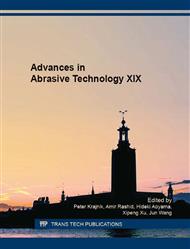p.362
p.368
p.375
p.381
p.389
p.395
p.401
p.407
p.415
Chemical Mechanical Polishing on Extremely Low Expansion Glass Ceramic Wafers
Abstract:
Extremely low expansion glass ceramics are widely used in integrated circuit (IC), liquid crystal display (LCD) lithography, high-precision measurement and astronomy, due to their excellent mechanical properties and chemical stability at higher temperatures. Nevertheless, the extremely low expansion glass ceramics are hard-to-machine materials due to their hard-brittle nature, resulting in cracking, chipping and scratching induced in conventional machining. This leads to higher surface roughness, and is not qualified for high-performance devices. In this study, surface roughness of 0.447 and 4.904 nm are achieved for Ra and peak-to valley (PV), respectively with a measurement area of 70×53 μm2 after chemical mechanical polishing (CMP). Firstly, the glass ceramic wafers are lapped using silicon carbide (SiC) abrasives on a cast-iron plate. After lapping, the wafers are polished by CeO2 slurry in a sequence of 3 μm and 500 nm in diameter, and polyurethane and floss pads are used correspondingly. Finally, CMP is employed on the glass ceramic wafers. Floss pad and silica slurry are used in CMP in an alkaline solution with a pH value of 8.5. After CMP, the wafers are cleaned and dried by deionized wafer and compressed air, respectively.
Info:
Periodical:
Pages:
389-394
Citation:
Online since:
October 2016
Authors:
Price:
Сopyright:
© 2016 Trans Tech Publications Ltd. All Rights Reserved
Share:
Citation:


